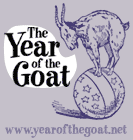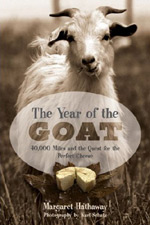Having never been to this sort of convention before, Karl and I had no idea what to expect. We weren't sure if it would fall into the general pattern for professional meetings — such as you would find within any occupational group, from English professors to bank managers — or if the week's entire structure and activities would be specific to small livestock farmers. (As it turned out, it was a little of both.) Mostly, we were just excited about the possibility of talking to goat farmers from across the country, and seeing if our first impressions about the raising of goats held true on a large scale.
Since the first half of the week was focused on the youth members, Karl and I only registered for the final few days of the convention. We arrived late on Wednesday morning, and unfortunately missed a couple of workshops that sounded really interesting, including "Starting a Successful Goat Business." Once we'd settled in, however, we tried to attend at least three workshops a day, and by the end of the convention, we'd been to lectures on goat diseases, foraging, goat judging, goat reproduction (during which the leader had us act out the process of hormone release by doing a carefully choreographed wave), starting a commercial dairy, marketing goat products, basic welding, cheese making, and organic goat farming in Costa Rica.
The workshops were fascinating, even when we lacked much of the basic knowledge to truly understand what was going on (having never delivered a kid, for example, we were quite a few steps behind the majority of the group). What was amazing to us was the passion that people invest in their herds. The majority of people who raise goats, we learned, hold down a day job, as well. The "goat habit," as I overheard someone call it, seems to be motivated purely by a love of the animals. A t-shirt for sale read "I'm an experimental: 50% human, 50% goat crazy," and, to be honest, that seemed pretty close to the truth. Everyone at the convention was just wild for goats, spending a great deal of their time and money to "promote the goat," as a bumper sticker read.
At Wednesday night's auction, the proceeds of which went to benefit the hosts of this year's meeting, the enthusiasm for goats led to some high peaks of excitement. After an hour of wine and cheese tasting, an auction of painted goat profiles was held. To everyone's amazement, some particularly nice paintings brought in as much as six hundred dollars each.
Saturday morning's Spotlight Sale, too, broke records with it's proceeds. The Spotlight Sale, in which a small number of exemplary animals are auctioned, was held after a champagne brunch on the final day of the convention. Goats with exceptional pedigrees were actually brought into the Marriott ballroom, their coats covered in Aqua Net and glitter, and led down a runway for the bidding. In the excitement, several of the goats relieved themselves beneath the spotlight. We got caught up in it, too, and momentarily entertained thoughts of bidding, but with one buck, Willow Run Chevalier Ruffian, commanding a whopping $16,000, the auction was too rich for our blood.
Though we didn't leave with a goat, painted or live, Karl and I had a wonderful time at the convention. One of the great things for us, which we imagine is also the case for quite a few of the people who attended, was simply being with so many people who share our love of goats. We feel like we made a lot of new friends in Nashville, and we look forward to visiting as many as we can in the upcoming year. —MMH
More photographs from the ADGA National Convention:
Wednesday, October 29, 2003
Thursday, October 30, 2003
Friday, October 31, 2003
Video: ADGA'ers kick up their heels at the Costume Ball
Saturday, November 1, 2003


